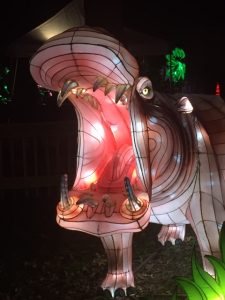ON THE LONGEST NIGHT OF THE YEAR, my mom and I strolled softly lit paths through the wooded grounds of the Central Florida Zoo during the Asian Lantern Festival. As we wandered, we encountered illuminated lanterns shaped like crescent moons and meerkats and life-sized hippotamuses—and, yes, tigers. Oh, my!
 Now
Now  that she’s 85, I treasure sharing quiet adventures like this with my mom. So I took pictures—lots of them. Of the tigers and cheetahs and dragon lanterns, yes. But also of my mom. Because these are moments I’ll want to remember, and the pictures will help me do so. But I know I can drop even deeper into those moments by writing about the photos that capture them.
that she’s 85, I treasure sharing quiet adventures like this with my mom. So I took pictures—lots of them. Of the tigers and cheetahs and dragon lanterns, yes. But also of my mom. Because these are moments I’ll want to remember, and the pictures will help me do so. But I know I can drop even deeper into those moments by writing about the photos that capture them.
In a blog post titled Why Do We Write? A New Year’s Exploration, I quick-list a dozen reasons I write (and in the post, I invite you to explore your reasons for writing, too!). While I somehow forgot to include “preserving memories” on that list, doing so is one of the wonderful gifts writing gives to us.
 I’m not alone in thinking this. Natalie Goldberg says writers live twice: first in their immediate experiences and second in writing about them. Of course, if we have photos of our experiences, we have the opportunity to home in on details we might have forgotten otherwise. And vice versa: When we write from photographs of our lives, we tend to discover what’s hidden beneath a photo’s surface.
I’m not alone in thinking this. Natalie Goldberg says writers live twice: first in their immediate experiences and second in writing about them. Of course, if we have photos of our experiences, we have the opportunity to home in on details we might have forgotten otherwise. And vice versa: When we write from photographs of our lives, we tend to discover what’s hidden beneath a photo’s surface.
Snapshot memoirs
There’s even a sub-genre dedicated to writing from our pictured memories, the snapshot memoir (also known as flash memoir). In this form, we may be writing from actual images—on our phones or in our photo albums—or from indelible snapshots in our mind’s eye. Either way, though flash memoir is different from flash fiction—because we focus on our own lives rather than on the created lives of imagined others—many of the rules of flash fiction apply to this super-short memoir form, too.
Readers Write: THE SUN MAGAZINE
THE SUN MAGAZINE has a wonderful feature called Readers Write, in which SUN readers are invited to write and submit their own snapshot-sized pieces about real-life moments. On THE SUN’s site, you’ll find examples of published Readers Write pieces as well as the prompts and guidelines governing their submission process.
Mini-memoir writing prompt
Setting aside just ten minutes with pen in hand and a photo in front of you, travel back to the moment the snapshot has captured in its frame. Allow yourself to enter the picture. Look around carefully. Now, peek outside the frame to your memory of the wider context. What’s going on to the left of the image? To the right? Who’s taking the photo? Why?
You might take a deep breath and dive into the emotions the image evokes—both the sweet feelings and the bittersweet. Or maybe the photo calls to mind associated memories that add to the meaning and magic of that particular instant in time.
However deep you’re ready to delve, imagine the photo  as a treasure map. It’s full of possibilities for sure! But to access the gold it promises, we need to follow the path the map reveals. When we write about the image before us, sentence by sentence, we step steadily toward riches the photo can only hint at. Because the real treasure lives inside us. And our pen creates the road that will take us there.
as a treasure map. It’s full of possibilities for sure! But to access the gold it promises, we need to follow the path the map reveals. When we write about the image before us, sentence by sentence, we step steadily toward riches the photo can only hint at. Because the real treasure lives inside us. And our pen creates the road that will take us there.








